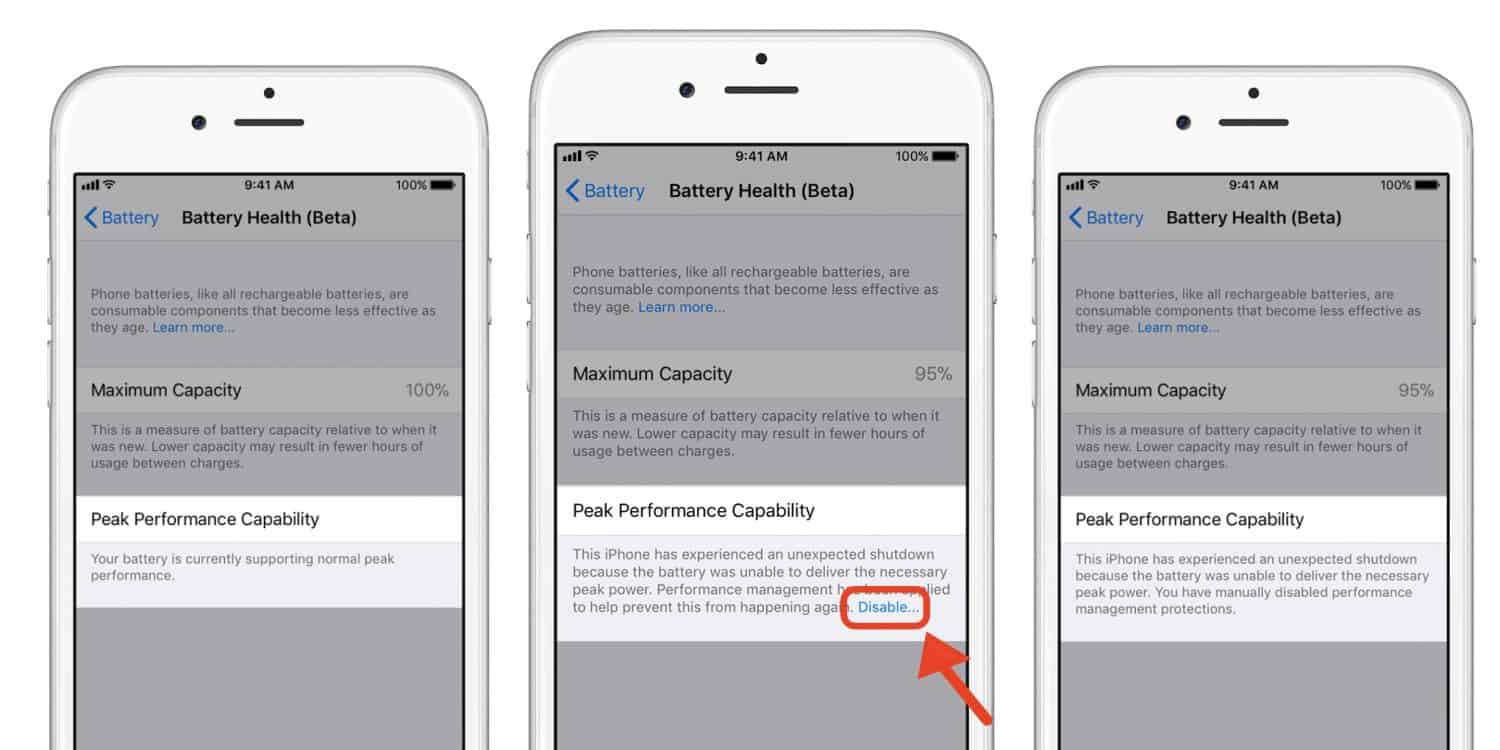
As promised, Apple has included a new screen in the iOS 11.3 beta 2 settings called Battery Health (Beta) available on all iPhones since iPhone 6. This view includes information about the maximum capacity of the battery in the device, and describes whether the battery has degraded to the point where it can no longer offer peak performance.
All devices upgrading to iOS 11.3 start with performance management disabled. It will be enabled by the system when the device first experiences an unexpected shutdown. However, users can go into Settings -> Battery -> Battery Health and disable it. See how (as well as all the different states) after the break
Apple says that all devices on iOS 11.3 begin with performance management features disabled. Performance management throttles CPU if the battery can no longer provide peak power output.
Currently, performance management may be enabled by the system on iPhone 6, iPhone 6 Plus, iPhone 6s, iPhone 6s Plus, iPhone SE, iPhone 7 and iPhone 7 Plus.
With iOS 11.3, it is now possible to disable performance management, stop the throttling, and restore full speed. Apple has also tweaked the algorithms that decide when performance management should come into effect. Apple says performance management is more ‘adaptive’ than it was before so that it can dynamically increase or decrease the amount it is used, without the user doing anything at all.
iPhone 8 and iPhone X include smarter hardware that enables Apple to more precisely apply power management, so noticeable effects of throttling on these devices should be less when it eventually kick ins. At the moment, these devices are so new they shouldn’t require peak performance management, and capacity should be either 99% or 100%.
Battery capacity can be viewed on any iPhone introduced in 2014 or later, starting with iPhone 6. With iOS 11.3 beta 2 installed, open Settings -> Battery -> Battery Health.
The Maximum Capacity readout gives an estimate of the amount of total capacity the battery can hold. New phones should report 100% capacity. A lower capacity means that the iPhone will not as long between charges.
The second section is titled ‘Peak Performance Capability’. You have to read the grey text beneath this cell to see whether battery management is in effect.
Your iPhone battery is supporting maximum performance
If the battery is still in good health to provide peak power, the screen will look like this. It simply confirms that the battery is supporting the maximum performance it can. There is no user action to be taken.
Your iPhone performance is being throttled
If the iPhone unexpectedly shutdowns because it cannot sustain maximum performance, the device will enter this state with performance management enabled. Performance management slows down the CPU dynamically to reduce peak power demands on the battery.
If you do not want to be throttled, users can get a battery replacement as ever or disable the throttling (new in iOS 11.3). To disable, select the blue Disable link. The iPhone screen will then look like the following screenshot, indicating that performance management has been disabled.
Note that if you disable performance management it cannot be toggled on again until the device unexpectedly shuts down. Apple says that it will automatically re-enable performance management each time the device unexpectedly shuts down.
This feature is not a permanent toggle that you can disable once and forget about it. If you never want to be throttled, you will have to go back into the Battery Health screen and repeatedly disable it each time.
Your iPhone battery is very degraded
In cases where the battery is severely degraded, often when maximum capacity has dropped below the 80% mark, Apple will still let users disable performance throttling but the likelihood of unexpected shutdowns increases. Apple will therefore include an additional notice in the Battery Health page directing users to get their battery replaced with a link to the various service options available.
In some instances, the system may be unable to determine battery health. The Battery Health screen will also direct users to get a replacement battery if this is the case.
Apple has posted a full explainer regarding iPhone battery health and preventing unexpected shutdowns on its website, if you want more information. iPhone batteries are designed to last for up to 500 cycles retaining at least 80% capacity. Batteries that do not meet these specifications may be eligible for free warranty repairs. Otherwise, battery replacements costs $29 through the end of 2018.
These screenshots come from iOS 11.3 beta 2. The section is labelled as a beta which suggests the final interface may change when the feature is released publicly in the spring.





